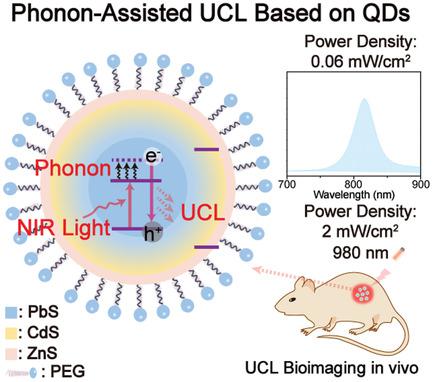Our official English website, www.x-mol.net, welcomes your
feedback! (Note: you will need to create a separate account there.)
Near‐Infrared Upconversion Luminescence and Bioimaging In Vivo Based on Quantum Dots
Advanced Science ( IF 14.3 ) Pub Date : 2019-01-18 , DOI: 10.1002/advs.201801834 Xiaochen Qiu 1 , Xingjun Zhu 1 , Xianlong Su 1 , Ming Xu 1 , Wei Yuan 1 , Qingyun Liu 1 , Meng Xue 1 , Yawei Liu 1 , Wei Feng 1 , Fuyou Li 1
Advanced Science ( IF 14.3 ) Pub Date : 2019-01-18 , DOI: 10.1002/advs.201801834 Xiaochen Qiu 1 , Xingjun Zhu 1 , Xianlong Su 1 , Ming Xu 1 , Wei Yuan 1 , Qingyun Liu 1 , Meng Xue 1 , Yawei Liu 1 , Wei Feng 1 , Fuyou Li 1
Affiliation

|
Recently, upconversion luminescence (UCL) has been widely applied in bioimaging due to its low autofluorescence and high contrast. However, a relatively high power density is still needed in conventional UCL bioimaging. In the present study, an ultralow power density light, as low as 0.06 mW cm−2, is applied as an excitation source for UCL bioimaging with PbS/CdS/ZnS quantum dots (UCL‐QDs) as probes. The speculated UCL mechanism is a phonon‐assisted single‐photon process, and the relative quantum yield is up to 4.6%. As determined by continuous irradiation with a 980 nm laser, the UCL‐QDs show excellent photostability. Furthermore, UCL‐QDs‐based probe is applied in tumor, blood vessel, and lymph node bioimaging excited with an eye‐safe low‐power light‐emitting diode light in a nude mouse with few heat effects.
中文翻译:

基于量子点的近红外上转换发光和体内生物成像
近年来,上转换发光(UCL)由于其低自发荧光和高对比度而在生物成像中得到广泛应用。然而,传统的伦敦大学学院生物成像仍然需要相对较高的功率密度。在本研究中,采用低至0.06 mW cm -2 的超低功率密度光作为UCL生物成像的激发源,以PbS/CdS/ZnS量子点(UCL-QD)作为探针。推测的UCL机制是声子辅助的单光子过程,相对量子产率高达4.6%。通过 980 nm 激光的连续照射确定,UCL-QD 显示出优异的光稳定性。此外,基于UCL-QDs的探针应用于肿瘤、血管和淋巴结生物成像,在裸鼠中用人眼安全的低功率发光二极管灯激发,几乎没有热效应。
更新日期:2019-01-18
中文翻译:

基于量子点的近红外上转换发光和体内生物成像
近年来,上转换发光(UCL)由于其低自发荧光和高对比度而在生物成像中得到广泛应用。然而,传统的伦敦大学学院生物成像仍然需要相对较高的功率密度。在本研究中,采用低至0.06 mW cm -2 的超低功率密度光作为UCL生物成像的激发源,以PbS/CdS/ZnS量子点(UCL-QD)作为探针。推测的UCL机制是声子辅助的单光子过程,相对量子产率高达4.6%。通过 980 nm 激光的连续照射确定,UCL-QD 显示出优异的光稳定性。此外,基于UCL-QDs的探针应用于肿瘤、血管和淋巴结生物成像,在裸鼠中用人眼安全的低功率发光二极管灯激发,几乎没有热效应。


















































 京公网安备 11010802027423号
京公网安备 11010802027423号